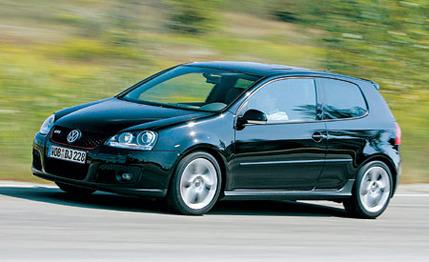 Short Take Road Test
Short Take Road Test
The GTI is the third of three cars to trickle into the U.S. that share the same platform from the Volkswagen/Audi juggernaut. First was the wagonlike five-door Audi A3 and then the Jetta GLI sedan.
All three have a 101.5-inch wheelbase, with a front strut suspension and a multilink rear. They all share a stout 2.0-liter direct-injection turbocharged four-cylinder that makes a healthy 197 horsepower and 207 pound-feet of torque, connected to either a six-speed manual or a six-speed "automated manual" known as Direct Shift Gearbox (DSG).
These are not easy acts to follow. We all fell in love with the A3's excellent ride-and-handling balance and quick reflexes wrapped in a useful wagon package. The GLI didn't fare quite as well. Staffers expected it to be more extreme and were disappointed by its modest acceleration.
VW sent us a Euro-spec GTI to test, since the U.S. cars won't be available for a couple more months. Our car came with the optional six-speed DSG, with shorter gearing and predictions of improved acceleration.
DSG is essentially two manual transmissions in parallel and two clutches. One clutch is connected to the odd gears, and the other to the evens. The two clutches alternate back-and-forth to provide smoother and quicker shifts than a single-clutch manual with electronic controls (BMW's SMG, for example). There's a fully automatic mode, or you can use the steering-wheel-mounted paddles to control the action, including eye-blink-quick upshifts and lovely matched-rev downshifts. As good as it is, DSG is still a little unpredictable when moving away from a stop.
For all-out acceleration, DSG has a launch-control feature in which the engine holds at 3000 rpm and, when the brake pedal is released, takes off with a tuned amount of clutch slip and wheelspin. Using this method, we managed a 6.0-second 0-to-60-mph sprint and a 14.7-second quarter-mile at 95 mph, even though we thought the computer allowed too much wheelspin.
That acceleration to 60 mph shames the GLI's and A3's by 1.1 and 0.5 seconds, respectively. And the quarter-mile is only 0.4 second slower than that of the limited-production, 240-hp hot-rod R32.
The interior of the GTI is nearly identical to the GLI's, and although the all-black look is dull, the plastics appear to be high quality. We particularly like the race-car-like steering wheel and heavily bolstered seats that hold occupants in place and yet are comfortable for the long haul. But they're not as good as BMW's new 3-series sport seats, which adjust in more ways and are simply more pleasing to the backside.
This GTI rides roughly and clomps over bumps. It also has a raspy exhaust note punctuated by a staccato blast during upshifts, but these traits help to give it a different, more aggressive attitude than its platform-mates', and that's the way we think it should be. The hunkered-down stance and the 225/45R-17 Bridgestone RE040 summer tires helped to pull an impressive 0.90 g on the skidpad and to stop from 70 mph in 162 feet, beating both the A3 and GLI. However, VW says our version will be raised 0.4 inch to improve the ride in our pothole-ridden states, so unfortunately, the GTI may lose some of its performance-oriented edge.
That leaves the question of price, which will also be a critical point of differentiation when the GTI hits the market in February. The A3 starts at $25,460; a Jetta GLI goes for $24,405. VW says the GTI will cost "thousands less" than those models, but a 2005 GTI with the 200-hp VR6 started at 23K, and we don't think the '06 will be less than that. Our car had roughly six grand in options, but only the DSG (for about $900) enhanced performance.
However, if the GTI's attitude makes it to U.S. models, it will be a sporty alternative to the upscale A3. We'll let you know in a couple months.